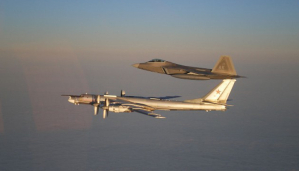
Russian officials say they plan to send long-range bombers to the Gulf of Mexico in a military maneuver that has many Americans feeling a bit uneasy.
Russia's Defense Minister Sergey Shoigu said Wednesday that the country needs to "maintain military presence in the western Atlantic and eastern Pacific, as well as the Caribbean and the Gulf of Mexico" as part of a series of drills the country is enacting due to increased military tension throughout West Asia and Eastern Europe.
Currently, Russia is having a conflict of its own in the Ukraine, an area that NATO officials say has seen increased military presense from Russia in the last few months, while Russia denies the allegations. Earlier in the year, Russia annexed the Crimea region from the Ukriane, which has caused even more hostility in the area.
"In many respects, this is connected with the situation in Ukraine," Shoigu said, "With fomentation of anti-Russian moods on the part of NATO and reinforcement of foreign military presence next to our border."
But this proposed move into the Gulf of Mexico, some 6,000 miles away from Crimea and the Ukraine, has many scratching their heads. It's no secret that Russia and the United States are suffering from a new tension that some are even calling the new Cold War, but the U.S. State Department says there's no conflict they're away of that would warrant Russia to be in that area.
"We don't see the security environment as warranting such activity," spokeswoman Jen Psaki from the State Department said. "We don't think there is a current situation in the western Atlantic and eastern Pacific or the Caribbean and the Gulf of Mexico that warrants additional flights in out-of-area territory."
This isn't the first time Russian planes have flown near the U.S. border this year. In June, U.S. fighter jets intercepted two Russian planes that were seen 50 miles from the California coast. This was reported by the North American Aeroscape Defense Command as the first time U.S. jets intercepted Russian planes so close to our airspace in over two years. International law cites the U.S. territory to stretch 13.8 miles off the coast of California, so the Russian planes were still well within the International airspace laws.
In September, the U.S. intercepted six Russian planes in airspace outside of Alaska. Officials note that Russia is stepping up its military presense as the country enjoys an economic resurgence after the Cold War.
With the fighting in Ukraine growing more intense, NATO will be keeping an eye on Russia and its new military growth and presence increases around the world. While official don't expect any deliberate action against the West, accidents can and have happened, often soiling relations unintentionally.
A Russian aircraft nearly collided with a Swedish passenger jet in March, which would have been tragic for the 132 people on board. The 2001 incident involving a U.S. spy plane colliding with a Chinese passenger jet is a good example of how those tyes of operations can quickly turn scary.
Jeffrey Mankoff at the Center for Strategic and International Studies is concerned that the Russians are just trying to make a point that reflects the United States' own presence near Russia. "If they can do it to us, we can do it to them," he said, voicing the proposed Russian opinion.







